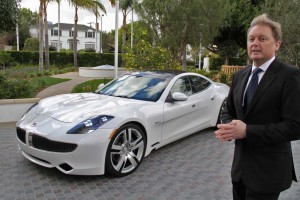UPDATE: Fisker has fixed and returned Consumer Reports’ Karma. Click here to read the story.
Now that the Fisker Karma has finally reached production, problems with the beautiful extended-range electric vehicle are starting to pile up.
The latest trouble with the $100,000 car came when Consumers Reports was just beginning its testing of the Karma luxury sports car when it died, according to a report from Reuters.
In a statement, Fisker said it has sent two engineers to assess the problem.
In the last month, Fisker appointed a new CEO, Tom Lasorda, a former Chrysler executive, to replace the company’s eponymous founder, Henrik Fisker. Fisker co-founded the company and designed the Karma, which has met with critical acclaim for its sleek styling. The company has dealt with a leak from its 2o kWh lithium-ion nanophosphate battery, supplied by A123. And it has shut down work at its U.S. plant, where it hopes to build its second model, called Nina, while it renegotiates with the terms of a $529 million loan from the U.S. Department of Energy. It also had to halt sales in January to fix a software glitch.
Click here to read about Fisker’s new CEO.
The company also finds itself defending a lawsuit by a disgruntled investor.
Click here to read the story about the lawsuit.
“It’s important to note that with more than 400 Fisker Karma sedans already on the road in the U.S., we also have many satisfied customers who are enjoying daily commutes in their cars,” Fisker said in its statement.
Consumer Reports, which buys the cars it tests anonymously, bought the car last week. It was doing initial speed calibrations at the magazine’s test track in East Haddam, Conn., when the battery light on the instrument panel lit up. After parking it, the car refused to restart.
A contractor builds the Karma in Finland. Fisker plans to build its second model, the Nina sedan, at its Wilmington, Del. plant, a former General Motors Co factory.
Like General Motors’ Chevrolet Volt, the Karma operates on battery power for dozens of miles on a full charge. When the battery is exhausted, a gasoline engine powers the car, providing range similar to a regular vehicle.
Critics have lauded the Karma for its sleek, sexy styling, but also derided for its poor rear-seat space, poor cargo space, hefty weight and marginal fuel economy.
Click here to read TheDetroitBureau.com’s first drive of the Karma.

